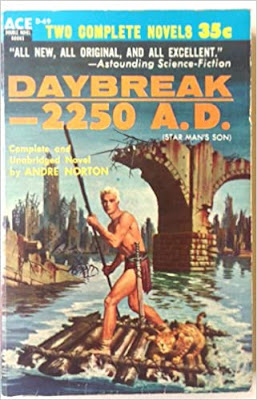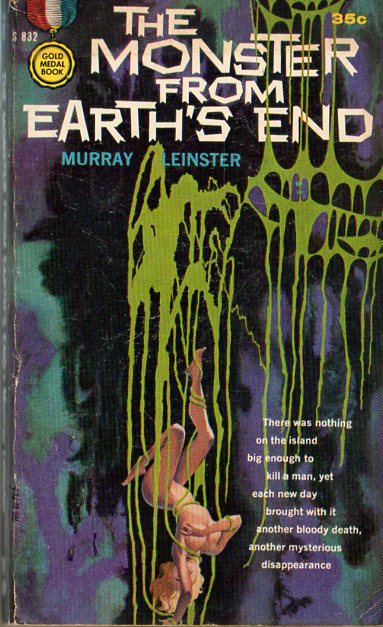Daybreak 2250 A.D. by Andre Norton
 Not for the first time since I began rereading Andre Norton’s science fiction and fantasy, I discovered that I remembered the titles of this novel (there are two), the main character, the fact that I loved it when I first read it, and nothing else. I do understand why Star Man’s Son became Daybreak etc.: the original title makes one think one will be getting a space adventure, but that’s not what it is at all. Though right at the end, there is an explanation.
Not for the first time since I began rereading Andre Norton’s science fiction and fantasy, I discovered that I remembered the titles of this novel (there are two), the main character, the fact that I loved it when I first read it, and nothing else. I do understand why Star Man’s Son became Daybreak etc.: the original title makes one think one will be getting a space adventure, but that’s not what it is at all. Though right at the end, there is an explanation.What we have here is a postapocalyptic quest across a blasted landscape full of mutants and
ruined cities, with huge piles of rusted machinery, and “blue areas” where no one goes because of the radiation. Plucky protagonist Fors is the proto-Norton hero (and later heroine): all alone, friendless except for an awesome animal companion, and exiled from his mountain tribe because he’s different. He’s dreamed all his life of becoming a Star Man like his father, an explorer and looter (in so many words) of the Old Ones’ remnants and a seeker after forgotten knowledge.
Fors is not only a mutant, he’s mixed race: his otherwise completely invisible and unregarded mother was (is?) one of the nomadic Plains people. He knows he’s a mutant because his hair is white and he has exceptionally keen hearing and night vision. His ability to communicate telepathically with his cat Lura appears to be normal and unremarkable.
Lura for her part is also a mutant: a puma-sized Siamese cat who is, as I said, telepathic. Her species often forms bonds with Fors’ tribe, and specifically with Star Men. She’s very independent and stays with Fors because she wants to; he can use her up to a point, but past that she doesn’t cooperate and he doesn’t push his luck.
After he is finally and conclusively rejected by the Star Men, Fors steals his father’s belongings and takes off into the wild. He hopes to find the ruined city his father supposedly found before he died, and to bring back enough valuables to essentially buy his way into the Star Men.
He does in fact find the city, with remarkably little difficulty, and in the process meets a stranger, Arskane, who is a scout for his own tribe. Arskane’s tribe has been driven out of their lands by volcanic eruptions and is looking for a place to settle.
It is stated implicitly that Arskane is Black. Fors is white, and so are the Plains people. (The actual Plains Indians do not exist, though there’s mention of people in the forests who state that they were the original inhabitants.)
Fors’ luck runs out after he finds a museum in the city. While he’s congratulating himself on his success, the vile and evil Beast Things find the humans and the cat. Their only hope for escape is to run through an atom-blasted wasteland, on the other side of which they run afoul of a new incursion of Plains horsemen under the command of a warlord with ambitions.
The Plainsmen are out to take over, Arskane’s people just want to find a place to settle down, and the inhuman Beast Things want to kill all of them horribly. Ultimately Fors joins forces with the Star Captain, Jarl, who originally rejected him and who is now allied with the Plainsmen. Jarl concocts a plan to use Arskane’s people to drive the Beast Things toward the Plainsmen, thereby distracting them from their campaign of human conquest and compelling them to fight together against the common enemy.
Fors is delegated to serve as bait. Inevitably he’s captured and tortured, but the plan succeeds. Farmer/artisans and horsemen cooperate to destroy the nonhumans. The farmers find a place to settle, the warlord dies heroically leaving much less aggressive people in charge, and both sides offer to accept Fors among them.
But Fors is stubborn. He insists on going back home to the mountain Eyrie and pleading his case. To his amazement, Jarl speaks up for him, exonerates him, and offers him a new form of Star Man-ship: a sort of ambassador to the various peoples of their broken world. He also reveals the secret at the core of both the order and the Eyrie, that their ancestors were developing a space program. They were literally aiming for the stars.
Jarl speculates that they all must be mutants by now, or they would never have survived the radiation after the bombs fell. (And we the readers observe that telepathy is one of the things that’s taken for granted here which most certainly was not in the pre-atomic world.) We’re all one world and one people, he declaims, and it’s time to get back together and forge a new, and someday starfaring, future.
I happen to have reread this book in the midst of one of the seasonal storms in the science fiction genre, with a particular faction declaring that science fiction in the good old days was completely apolitical, and we should all go back to that. I found this particularly interesting in light of the fact that this novel was first published in 1952. It’s the oldest of all the Norton novels I’ve read so far, and one of her very first published science fiction works. And it’s political from one end to the other. It’s a Message Novel in bright neon lights.
Here, seven years after the bombing of Hiroshima and Nagasaki, Norton gives us the complete destruction of Western civilization and the near-destruction of the human race. She knows about radiation poisoning, she speculates about the range and quality of mutations from it, and she makes it clear that she sees no other end to the atomic age than a cataclysmic blowup.
She also, even before Brown v. Board of Education and right in the middle of the McCarthy era, made clear that the future will not be pure white, though it may be relentlessly patriarchal. Her hero may have fair skin but he’s something other than Aryan-Caucasian, and his closest friend is African-American, descended from the Tuskegee Airmen. The implicitly white Plains people actually have a female leader, and the only women who speak in the whole novel speak at the end against the men’s insistence on perpetual war.
This is pretty radical for the dawn of the Eisenhower era. Fors grows through the novel to become a uniter of tribes, and the overriding message is that war is evil, humans need to stick together, and racism based on skin color is a bad idea.
From the perspective of 2018, there are problematical elements. Norton calls out racism and colonialism and speaks strongly against war, but buys completely into the patriarchy. She has one token female leader who plays the token female role of lone pacifist among the warriors, and one token Adorable Little Girl who inspires Fors to go along with Jarl’s plan despite the cost to himself. Fors’ mother is a complete cipher—serious missed opportunity there for him to claim her half of his heritage while dealing with the Plainsmen. Women for the most part are invisible when they’re not property, and they play no role in Fors’ life or world view.
That’s not the only problem. Norton literally dehumanizes the enemy. It’s human exceptionalism on a global scale, turning the big bad into hideous Beast Things. Initially I thought they must be mutated rats, which might not have been quite so bad (considering the history of rats versus humans, Plague, etc., etc.), but late in the story Fors and company speculate that they’re either mutated city folk or radiation-damaged opponents in the atomic war. No one speculates about where the enemy came from, just that they must have turned into inhuman, subhuman, vicious and cannibalistic monsters. This form of antagonist became a trope as the years and the books went by, in the Witch World as well as the science-fiction worlds—though by the time of the Simsa books, Norton’s sentient villains turned out to be various forms of human.
It was completely serendipitous that I read Daybreak immediately after the Simsa books. Luck of the bookshelf arrangement, is all. But there’s a distinct link between the books, from the silver-haired mutant with the telepathic animal ally to the secondary protagonist who is a man of color, to the history itself: Thom tells of an atomic holocaust that killed off most of Earth’s humans, leaving the few survivors forever changed. Two of the changes were a high tolerance for radiation, and enhanced psi powers.
Apolitical? Not even slightly. (Judith Tarr, Tor.com)


Comments
Post a Comment